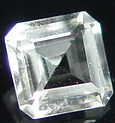Hambergite
Hambergite is one of the lesser-known gemstones. It is usually nearly colorless, with the vitreous luster of glass when cut. It is quite a hard material, with a hardness of 7.5 on the Mohs scale, so it takes a very good polish.
Hambergite is named after the Swedish Mineralogist, Axel Hamburg. It forms in flattened prismatic orthorhombic crystals with vitreous to dull luster. It is a brittle mineral with perfect cleavage in one direction and conchoidal to uneven fracture. Hamberg taught crystallography and mineralogy at Stockholm University and then became professor of geography at Upsala University. From 1913 to 1927 he was president of the International Iceberg Commission.
Hambergite was originally discovered in southern Norway but that material was not clean enough to be considered gem material. The most important current source is probably in Anjanabanoana, Madagascar. Recently, some nice material has also been unearthed in Molo, Myanmar, but most of the crystals are small.
Hambergite has the lowest known density of any gem with such a high birefringence (.072). These unique properties make it easy to identify. Stones have little fire any may resemble quartz but with the high birefringence, hambergite is nearly impossible to misidentify. Gem quality hambergite can be found in Kashmir (India), as well as in Madagascar.
